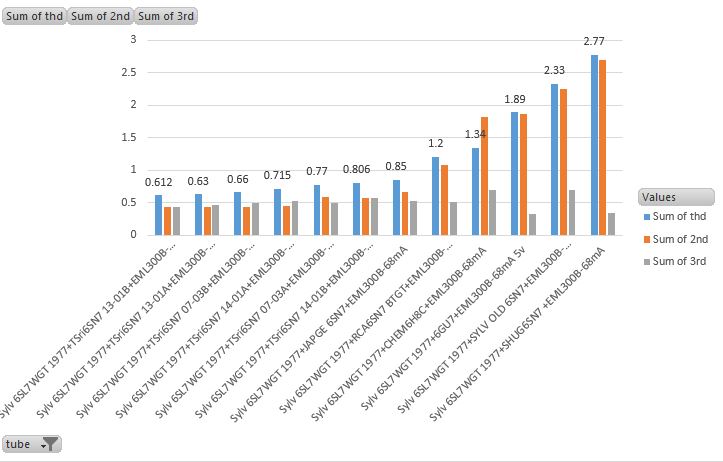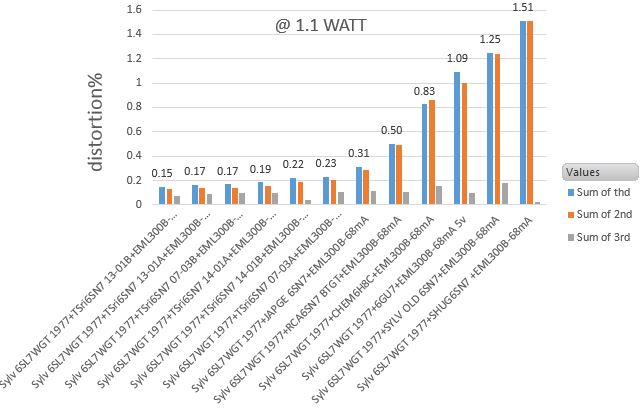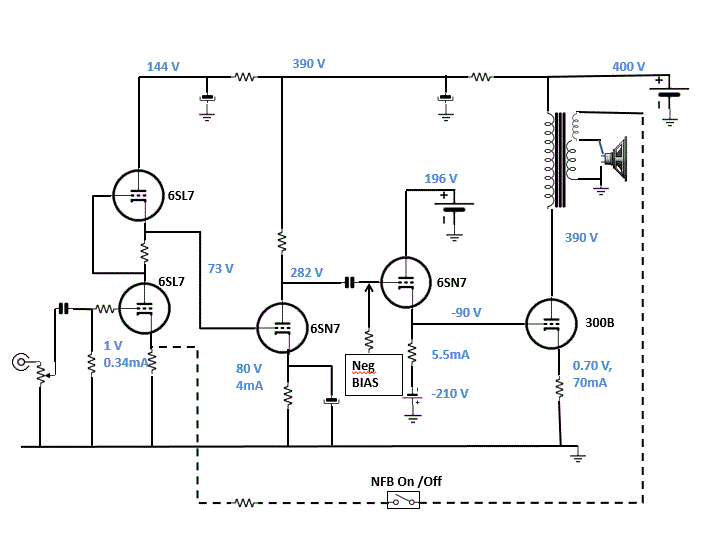uTracer? Ronald's electronic project site
I built one to do just that, so I can model the actual tubes I will be using. It's a quick and easy way of generating models. If you use the Derk Reefman's "Extractmodel" you get Koren & Derk parameters for your tube. You can also chose the measurement range to get a best fit for your tube operating conditions so you can do some optimisation that way.
I have done some parameter extraction for folks who have sent me tubes to measure, it's not a "service" but I am happy to do it FOC because that way I get to learn more about tubes
In my amplifier all the 6 Tung Sol reissue 6SN7 I have gives much lower distorion in my amp than any other 6SN7 I got. I think the difference should be visible also when tracing the indiviual tube curves..and comparing . Something is special with the TS 6SN7..

Best regards Balle
Reducing the power from 4.5wat to 1.1Watt gives the same trend, but quite horrific distortion for some non-Tungsol tubes.

With this 6SN7 model I get 0.67 %THD at 1.1 Watt
* 6SN7 sylvanie LTSpice model
* Modified Koren model (8 parameters):
* Traced by erik 25/12/2013 using Curve Captor v0.9.1
* from datasheet tracer
*
* 6SN7WGTk8 LTSpice model
.subckt 6SN7WGTk8 P G K
Bp P K I=(0.02170661176m)*uramp(V(P,K)*ln(1.0+(-0.1418880099)+exp((5.336202785)+(5.336202785)*((22.20702463)+(-20.28905564m)*V(G,K))*V(G,K)/sqrt((-0.0001481184562)**2+(V(P,K)-(-11.62245799))**2)))/(5.336202785))**(1.347919701)
Cgk G K 2.4p ; 0.2p added
Cpk P K 1.2p ; 0.5p added
Cgp G P 4.2p ; 0.5p added
Rpk P K 1G ; to avoid floating nodes
d3 G K dx1
.model dx1 d(is=1n rs=2k cjo=1pf N=1.5 tt=1n)
.ends

With this 6SN7 model I get 0.67 %THD at 1.1 Watt
* 6SN7 sylvanie LTSpice model
* Modified Koren model (8 parameters):
* Traced by erik 25/12/2013 using Curve Captor v0.9.1
* from datasheet tracer
*
* 6SN7WGTk8 LTSpice model
.subckt 6SN7WGTk8 P G K
Bp P K I=(0.02170661176m)*uramp(V(P,K)*ln(1.0+(-0.1418880099)+exp((5.336202785)+(5.336202785)*((22.20702463)+(-20.28905564m)*V(G,K))*V(G,K)/sqrt((-0.0001481184562)**2+(V(P,K)-(-11.62245799))**2)))/(5.336202785))**(1.347919701)
Cgk G K 2.4p ; 0.2p added
Cpk P K 1.2p ; 0.5p added
Cgp G P 4.2p ; 0.5p added
Rpk P K 1G ; to avoid floating nodes
d3 G K dx1
.model dx1 d(is=1n rs=2k cjo=1pf N=1.5 tt=1n)
.ends
Last edited:
@sleiven,
That is very interesting but I'd like to see a schematic of the amplifier you're measuring. The distortion is all 2H and interestingly the Shug with the high 2H has the lowest 3H.
That is very interesting but I'd like to see a schematic of the amplifier you're measuring. The distortion is all 2H and interestingly the Shug with the high 2H has the lowest 3H.
@sleiven,
That is very interesting but I'd like to see a schematic of the amplifier you're measuring. The distortion is all 2H and interestingly the Shug with the high 2H has the lowest 3H.
Some harmonic cancellation is going on here..... that can explain high 2H:low3H, and low 2H:high 3H

Last edited:
For lower distortion try mu follower.. direct couple off the lower 6sl7 triode..
Sounds obvious.. but do you use grid stoppers?
Sounds obvious.. but do you use grid stoppers?
- Status
- Not open for further replies.